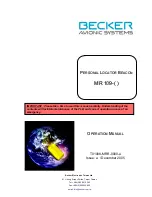
1
INTRODUCTION
Thank you for purchasing a Lowrance Avionics AirMap 300™. With its
large LCD screen, easy to use menus, and outstanding performance, we
think you’ll be happy with your AirMap 300 for many years. No other
handheld GPS receiver on the market today has the AirMap’s combina-
tion of 12 channel receiver, Jeppesen
®
database with obstacles (U.S. only),
ground and hydrographic mapping cartridge capability, and programmable
screens in a handheld unit.
Like most GPS receivers, your AirMap 300 doesn’t have a compass or
any other navigation aid built into it. It relies solely on the signals from the
satellites to determine its position. Speed, direction of travel, and distance
are all calculated from position information. Therefore, in order for it to
determine the direction you’re travelling, you must be moving, and the
faster - the better. This is not to say the unit won’t work at walking speeds
- it will. But the faster you travel, the easier it is for the unit to determine
your direction.
GPS works from satellites that transmit information to the world at very
high frequencies. One disadvantage to this frequency is that it’s “line-of-
sight”. In other words, the signals don’t bounce around like your local
radio or television. If you don’t have a clear view of the sky, or if you’re
inside a metal building, the unit probably won’t be able to pick up the
signals from the satellites. This is common among all GPS receivers. We
have found that using this product inside an aircraft is usually sufficiently
close to the windows and windshield that it works well. However, the in-
cluded remote antenna bracket and cable (model PA-2) lets you mount
the removable antenna on top of the dash, in case it’s required.
Another factor that influences the GPS’ position and navigation capabili-
ties is called selective availability or SA. This is small errors purposefully
injected into the transmitted signal from the satellites. The government
does this to degrade the system’s accuracy to civilian and foreign users.
Even with SA, GPS is the most accurate navigation system ever invented
on such a large scale. The Government’s accuracy specification is 100
meters horizontally and 150 meters vertically 95% of the time. In other
words, the position shown on your AirMap 300 could be up to 100 meters
in any direction from your actual position, and the altitude could be plus or
minus 150 meters from what’s shown on the screen, 95% of the time.
One way around the S/A problem is to purchase a DGPS receiver and
connect it to your AirMap 300. A DGPS receiver (commonly called a bea-
con receiver), picks up correction signals broadcast from ground stations.
Содержание AirMap 300
Страница 1: ...INSTALLATION AND OPERATION INSTRUCTIONS AirMap 300 TM...
Страница 85: ...81 WINDOW BOXES These boxes are used on Map 3 and Nav 1 only 1 2 3 4 5 6 7 8 9 10 11 12...
Страница 86: ...82 13 14 15 16...
Страница 87: ...83 WINDOW GROUPS This is a listing of window groups A through O A B C D E F G H I J K L...
Страница 88: ...84 M N O...
Страница 94: ...90...





































